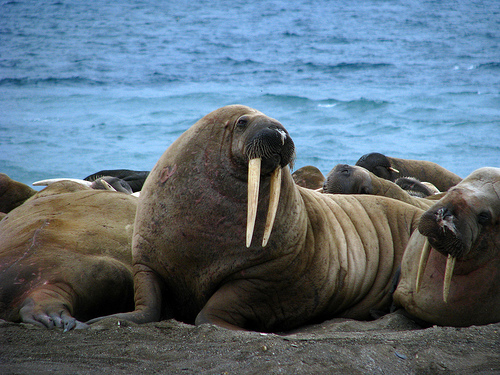Walruses are gentle giants with super strength.
- Walruses are large mammals that live in the Arctic areas of the Northern Hemisphere, including the Atlantic Ocean and the Pacific Ocean.
- Walruses have the scientific name Odobenus rosmarus, of which there are up to three subspecies, and they are the only extant member of the family Odobenidae, a family of pinnipeds or seals.
- Walruses can weigh 400 to 2,000 kilograms (880 to 4,400 pounds) in weight and grow up to 2.2 to 3.5 metres (7.2 to 11.5 feet) in length.
- Walruses have two long tusks that can be 1 metre (3.3 feet) in length, that are used for latching onto and digging holes in ice, and in males they are used for fighting.
- A female walrus usually gives birth to one pup during spring, not more than once every two years, around the time they migrate north, and the animal’s life span is generally between 20 to 50 years.
 A Herd of Walruses
A Herd of Walruses
Image courtesy of Claumoho/Flickr
- Walruses generally hunt for food in the water in small groups, and typically eat shrimp, coral, worms, molluscs, sea cucumbers and other small aquatic animals.
- Data relating to walrus populations has been difficult to obtain, making it difficult to determine whether they are endangered or not, however, they were heavily hunted in the 1700 and 1800s, causing a significant population decrease, and in some areas, extinction.
- Legislation in some areas has protected the walrus for almost a century, however they have been illegally poached for their tusks, blubber, hide, meat and flippers, and now it is only legal for them to be hunted by local natives to the area, although permission has been granted to allow natives to include other hunters to participate in the hunt under special conditions.
- A walrus has skin typically coloured brown to grey, that is scattered with hairs, and the animal also has whiskers above its mouth that are used as sensors.
- Walruses live on ice in herds that can number in the thousands, with adult males usually living in a separate group to the females and their pups, and they are sometimes preyed on by orcas and polar bears.
Bibliography:
Walrus, 2013, A-Z Animals, http://a-z-animals.com/animals/walrus/
Walrus, 2014, National Geographic, http://animals.nationalgeographic.com.au/animals/mammals/walrus/
Walrus, 2014, Wikipedia, http://en.wikipedia.org/wiki/Walrus






